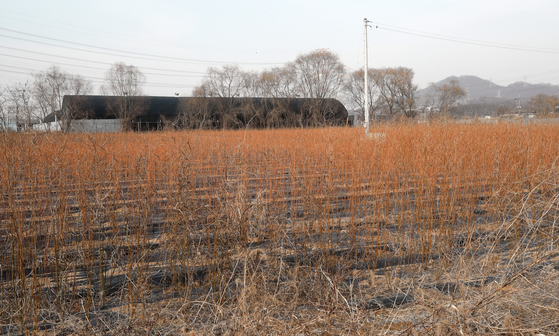Last year, it was confirmed that non-housing real estate mortgage loans such as land increased by more than 30 trillion won in mutual financial sectors such as Unit Nonghyup. It is pointed out that mutual finance is becoming a detour path for speculation. Earlier, employees of the Korea Land and Housing Corporation (LH) received a loan of 4.3 billion won from one of the North Siheung Agricultural Cooperatives to buy land in Siheung, Gyeonggi Province.

The crops are dry on the farmland located in Gwarim-dong, Siheung-si, Gyeonggi-do, bought by LH employees. News 1
According to data received from the Financial Supervisory Service by the Office of the People’s Power Yoon Chang-hyun on the 14th, the balance of non-housing real estate mortgage loans from mutual finances such as Nonghyup, Suhyup, Credit Union, and Forestry Association was estimated at 257 trillion won as of the end of last year. Compared to 2019, the amount was 30.7 trillion won, and the growth rate increased by 13.5%. It is the highest level since the end of 2017, when the number can be confirmed in terms of the year-on-year increase.
Non-residential real estate mortgage loans submitted by the Financial Supervisory Service include all real estate loans excluding houses such as land and commercial buildings. However, in the case of commercial buildings, since it is easy to borrow from commercial banks, most of them are likely to be land loans, as there is a high possibility that mutual financial institutions with high interest rates will not be used.
In the financial sector, it is expected that there will be quite a lot of cases where land is borrowed as collateral for speculation rather than double farming. LH employees who are suspicious of speculation also submitted agricultural management plans to local governments and received 4.3 billion won loans only from the North Siheung Agricultural Cooperatives.
The reason why non-housing real estate mortgage loans such as land is concentrated in the mutual financial sector is because the amount that can be borrowed is large. Commercial banks have to manage the average total debt repayment ratio (DSR) to within 40%, so the standards for lending are relatively strict. On the other hand, mutual financial institutions such as the Nonghyup only need to set the average DSR to 160% by the end of this year. From the lender’s point of view, it is easy to borrow more money than income. As of the end of March 2019, the average DSR of non-housing mortgage loans in the mutual financial sector was 363.8%.
The mortgage recognition ratio (LTV) is also more spacious than commercial banks. The financial authorities have managed to manage the LTV standard of non-mainstreamed mutual finance at a level of 40~70% through administrative guidance. In the case of North Siheung Nonghyup, LTV was applied up to 70% of the appraisal value. On the other hand, in the case of land, commercial banks lend LTV at a maximum level of 60% of the appraised value.
The financial authorities are considering including a plan to regulate non-housing mortgage loans in the mutual financial sector in the household debt management plan announced during this month. Finance Commissioner Eun Seong-soo said on the 11th, “I will take a look at the need for regulation of the land part.” Currently, measures to reinforce the DSR regulations of mutual finance or to reduce LTV are being discussed.
An official from the Financial Services Commission said, “Rather than restricting the LH speculation suspicion, we have looked at the status of loans in mutual financial sectors since the beginning of the year in terms of household debt management.”
Reporter Ahn Hyo-seong [email protected]
![]()
